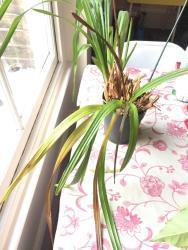Reposted from:
The thread "Cymbidium Leaf Markings" in
Orchid Insect and Disease Control-Part 1
fano16 said:Dear All.
my cymbidium going very badly. Is a 5 years old plant. Just repot 1 month ago. Leaves continue to get yellow and in 1 or 2 days and then fully brown. No linear necrotic marks.
Can it be dehydration? can it be lack on fertilizer (unfortunately never given).
Please let me know if there's a way to save it, I really need it.
Many Thanks

@fano16
Could you please let us know how often you're watering and what media you used? I'm also concerned by what appears to be white stuff on the leaves in the top centre of the photo (although it might just be a reflection, since it looks like you recently watered it).
In my experience if the leaves are yellowing and dying from the tips first (along with the pseudobulbs shrinking and becoming wrinkly), it's dehydration. If they start browning/dying from the bulb end and suddenly collapse, it's rot from overwatering. It looks like the former in your case.
Here's the problem, though - dehydration symptoms can be caused by both under and overwatering. If the roots have been severely damaged in the repot or have suffocated and died due to overwatering, they'll no longer take up moisture and so the symptoms of dehydration will appear.
Another factor is that certain species and their immediate hybrids absolutely hate being repotted (i.e.
tracyanum will sulk and appear dehydrated, whilst
sanderae will slow its growth to an absolute crawl for the next year).
The bulb at the front of the photo (with the brown leaves in the centre) is almost certainly going to go leafless. Hopefully, though, we can sort out the problem and stop the rest losing all their leaves (particularly that new growth at the back right).